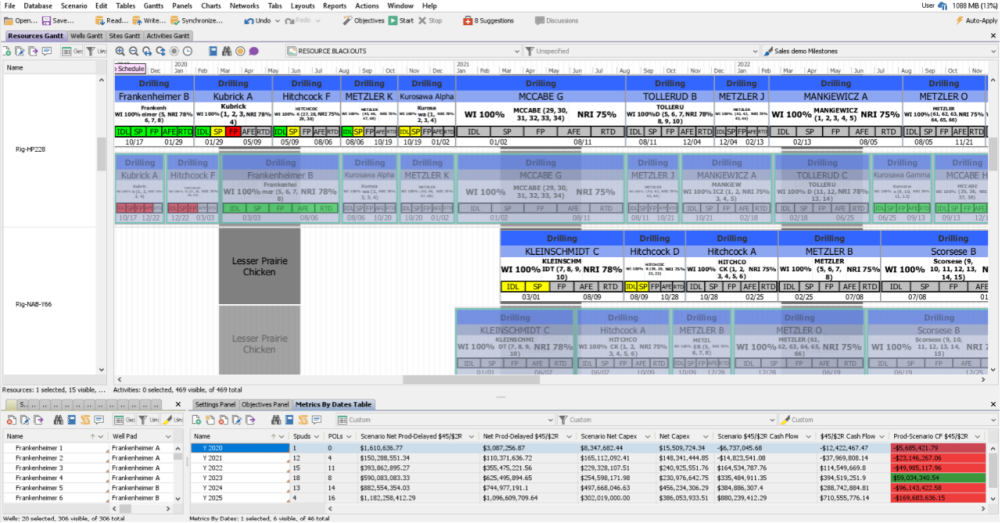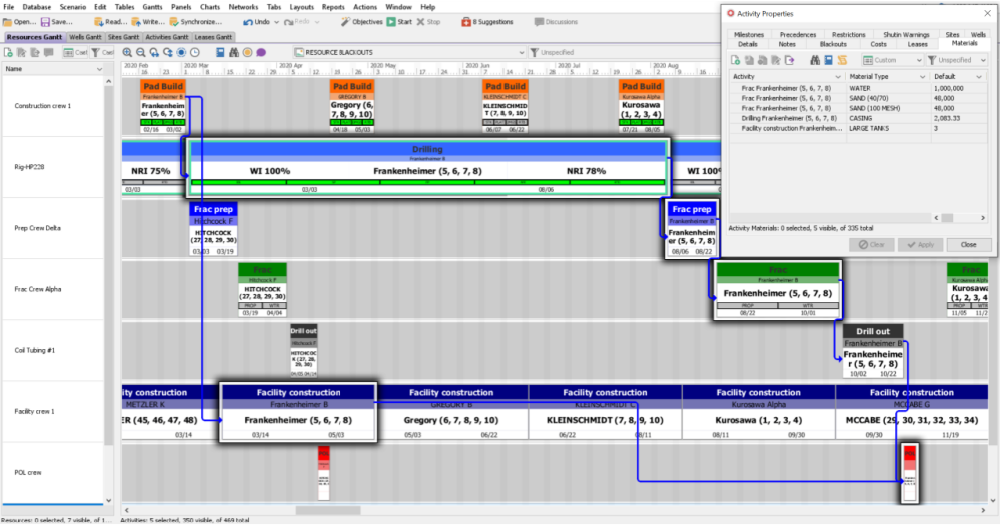
(Source: Actenum Corp.; Shutterstock.com)
[Editor's note: A version of this story appears in the July 2020 edition of E&P. Subscribe to the magazine here. It was originally published July 2, 2020.]
In the face of the current downturn, operators are looking for ways to ensure assets and resources return maximized value, especially in their drilling programs where optimal utilization and minimal downtime of rigs are critical. While more companies in the industry are digitizing their operations, selecting scheduling software for their operations is emerging as a new way to maximize return on assets and lower risk.
Recently, a U.S. E&P company was confronted with the drawbacks of not using digital well scheduling. The company had gone through years of organic growth accompanied by a series of acquisitions, each having its own way of scheduling. The company had no single, uniform process to schedule its operations across drilling, completions and facilities disciplines. In addition, its efficiency and revenues were being negatively impacted because, as it had grown, so did its number of well delivery scheduling methods. Adding to this problem was the fact that Big Data was coming to the forefront in the industry, further emphasizing the need for a central scheduling platform.
The company explored five different scheduling software solutions, including a custom-built in-house application. Based on its data model, visualization capabilities, ease of integration, ability to run multiple scenarios and compare analytics plus more, the company selected Actenum’s schedule optimization software.
A single source of the truth
The software provides a single source of truth for all drilling activities without having to rely on multiple spreadsheets. Everyone sees the same information at the same time in one place and understands why schedule changes are being made. Using a single platform that is accessible anywhere, it also promotes collaboration between team members and 24/7 planning from everywhere.
Scheduling a well delivery project with more than a handful of rigs and wells is a demanding process for two key reasons. First, making appropriate decisions about how to assemble and manage the schedule is complex because of the number of possible alternatives at any given point. As activities and resources are added to a schedule, the number of sequencing/timing constraints to be satisfied increases exponentially. For example, while scheduling two drilling rigs over 25 wells is reasonably straightforward, as additional rigs, wells and other well delivery activities are incorporated, the process becomes difficult to manage well.
Secondly, well delivery scheduling operates in an inherently dynamic environment. Any given schedule will only be valid for a short period, circumstances change because of planned and unplanned events, and rescheduling must be done. With numerous wells, the E&P company needed to consider these challenges going forward. Initially, the company wanted to schedule only drilling and completions using the Actenum software. However, after starting a pilot program with one business unit, three months later all business units within the company were using the software.


Rapid configuration
Configuration and implementation of the software are performed rapidly with the entire process typically completed within three to four weeks, including scheduling user training. For the E&P company, it was the fastest discovery-to-implementation process it had ever experienced. Additionally, for the first time, the company had an enterprise-wide scheduling system that provided management insight into all the activities going on across all business units.
Prior to implementation, the disciplines of drilling, completions and facilities worked in silos at the company. Each would make changes to their specific schedules without the other knowing. As a result, each discipline would have to laboriously check with the others to determine the impact of the changes, and even then, operations sometimes became unsynchronized. Using the software, as the composite schedule in real time, the impact of any change is reflected throughout all disciplines, and there is no more wasted time checking changes manually.
The company has found that one of the key benefits of the software is a reduction in the time it takes to make informed decisions. Prior to adopting the software, it took eight engineers two weeks to create and evaluate scenarios that would enable them to lock in their quarterly budget. After implementing the scheduling software, it took only one planning analyst and two engineers two days to complete this exercise.
A fundamental change at work
After only three months, Actenum scheduling software fundamentally changed the way the company worked. With the software, the company was able to create a comprehensive schedule that laid out well delivery tasks and resources so that everything was in one place and synchronized. Planning is now completed faster and more accurately, and the company gains immediate insights into how changes to the schedule impact costs and other business goals.
Recommended Reading
Enbridge Announces $500MM Investment in Gulf Coast Facilities
2024-03-06 - Enbridge’s 2024 budget will go primarily towards crude export and storage, advancing plans that see continued growth in power generated by natural gas.
Apollo Buys Out New Fortress Energy’s 20% Stake in LNG Firm Energos
2024-02-15 - New Fortress Energy will sell its 20% stake in Energos Infrastructure, created by the company and Apollo, but maintain charters with LNG vessels.
Summit Midstream Sells Utica Interests to MPLX for $625MM
2024-03-22 - Summit Midstream is selling Utica assets to MPLX, which include a natural gas and condensate pipeline network and storage.
Post $7.1B Crestwood Deal, Energy Transfer ‘Ready to Roll’ on M&A—CEO
2024-02-15 - Energy Transfer co-CEO Tom Long said the company is continuing to evaluate deal opportunities following the acquisitions of Lotus and Crestwood Equity Partners in 2023.
TC Energy, Partner Sell Portland NatGas Transmission System for $1.14B
2024-03-04 - Analysts expect TC Energy to make more divestitures as the Canadian infrastructure company looks to divest roughly $2.21 billion in assets in 2024 and lower debt.





